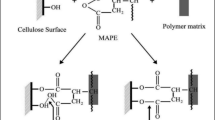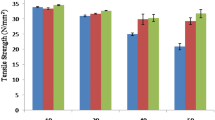Abstract
The manufacture of consumer goods from thermoplastic polymers leads to a considerable amount of scrap or off-specifications products, generating post-industrial waste that is typically landfilled. In present study, polypropylene (PP) wastes from the cotton swabs manufacture were used to the preparation of polymeric composites with agro-industrial waste of rice husk (RH). The RH was employed in the natural form as well as it was also treated by controlled pyrolysis for surface modification before incorporation to the PP. The PP/RH composites prepared by extrusion with contents from 2 to 20 wt% of non-pyrolyzed (NRH) and pyrolyzed (PRH) rice husk were submitted to the injection molding for preparation of tensile and impact specimens and characterized by mechanical testing, thermal analysis, melt flow rate, infrared spectroscopy and scanning electron microscopy. The controlled pyrolysis treatment on the RH caused significant changes in the thermal, chemical, rheological and mechanical properties of the PP/RH composites, mainly on the mechanical properties Young’s modulus, elongation at break and impact resistance that presented variation up to 100% when compared the composites containing NRH. The recycled PP/RH composites present suitable properties for several applications such as wood-plastic, furniture, doors and are an alternative for decrease the pollution generated by cotton swab waste.













Similar content being viewed by others
References
Ragaert K, Delva L, Van Geem K (2017) Mechanical and chemical recycling of solid plastic waste. Waste Manag 69:24–58
Rahimi A, García JM (2017) Chemical recycling of waste plastics for new materials production. Nat Rev Chem 1:0046
Niaounakis M (2019) Recycling of biopolymers—the patent perspective. Eur Polym J 114:464–475
Brüster B et al (2016) Thermo-mechanical degradation of plasticized poly(lactide) after multiple reprocessing to simulate recycling: multi-scale analysis and underlying mechanisms. Polym Degrad Stab 131:132–144
Singh N et al (2017) Recycling of plastic solid waste: a state of art review and future applications. Composites B 115:409–422
Maris J, Bourdon S, Brossard J, Cauret L (2018) Mechanical recycling: compatibilization of mixed thermoplastic wastes. Polym Degrad Stab 147:245–266
Panaitescu DM et al (2016) Vasilievic, Influence of hemp fibers with modified surface on polypropylene composites. J Ind Eng Chem 35:137–146
Sun L et al (2016) Thermal decomposition of fire-retarded wood flour/polypropylene composites. J Therm Anal Calorim 123:309–318
Zhao Y, Lv X, Ni H (2018) Chemosphere solvent-based separation and recycling of waste plastics: a review. Chemosphere 209:707–720
Lopez G et al (2017) Thermochemical routes for the valorization of waste polyole fi nic plastics to produce fuels and chemical: a review. Renew Sustain Energy Rev 73:346–368
Maddah HA (2016) Polypropylene as a promising plastic: a review. Am J Polym Sci 6:1–11
Geyer R, Jambeck JR, Law KL (2017) Production, use, and fate of all plastics ever made. Sci Adv 3:e1700782
Delva L, Hubo S, Cardon L, Ragaert K (2018) On the role of flame retardants in mechanical recycling of solid plastic waste. Waste Manag 82:198–206
Sanchez FAC, Boudaoud H, Hoppe S, Camargo M (2017) Polymer recycling in an open-source additive manufacturing context: mechanical issues. Addit Manuf 17:87–105
Al-oqla FM, Sapuan SM, Ishak MR, Nuraini AA (2015) A decision-making model for selecting the most appropriate natural fiber—polypropylene-based composites for automotive applications. J Compos Mater 50:543–556
Carbonell A, Samper MD, Balart R (2015) Green composites based on polypropylene matrix and hydrophobized spend coffee ground (SCG) powder. Composites B 78:256–265
Jiménez-Cervantes E et al (2014) Composites from chicken feathers quill and recycled polypropylene. J Compos Mater 49:275–283
Mustafa WA et al (2018) Structure analysis on polypropylene maleic anhydride (PPMAH)/polypropylene (PP)/recycled acrylonitrile butadiene rubber (NBRr) /banana skin powder (BSP) composites treatment. J Adv Res Fluid Mech Therm Sci 50:40–46
Ashenai F, Ghasemi I, Menbari S, Ayaz M (2016) Optimization of mechanical properties of polypropylene /talc/graphene composites using response surface methodology. Polym Test 53:283–292
Ashori A, Menbari S, Bahrami R (2016) Mechanical and thermo-mechanical properties of short carbon fiber reinforced polypropylene composites using exfoliated graphene nanoplatelets coating. J Ind Eng Chem 38:37–42
Assarar M et al (2016) Acoustic emission characterization of damage in short hemp-fiber reinforced polypropylene composites. Polym Compos 37:1101–1112
Ibrahim ID et al (2016) Mechanical properties of sisal fibre-reinforced polymer composites: a review. Compos Interfaces 23:15–36
Jiang X, Wang J, Wu G, Peng X (2019) Significant reinforcement of polypropylene/wood flour composites by high extent of interfacial interaction. J Thermoplast Compos Mater 32:577–592
Sullins T, Pillay S, Komus A, Ning H (2017) Hemp fiber reinforced polypropylene composites: the effects of material treatments. Composites B 114:15–22
Demirbas Ö, Ulus O (2017) Synthesis and characterization of polypropylene and CTAB modified diatomite composites. Int Res J Pure Appl Chem 13:1–9
Mulinari DR et al (2009) Sugarcane bagasse cellulose/HDPE composites obtained by extrusion. Compos Sci Technol 69:214–219
Aridi NAM, Sapuan SM, Zainudin ES, Al-Oqla FM (2016) Mechanical and morphological properties of injection-molded rice husk polypropylene composites. Int J Polym Anal Charact 21:305–313
Ummah H, Suriamihardja DA, Selintung M, Wahab AW (2015) Analysis of chemical composition of rice husk used as absorber plates sea water into clean water. ARPN J Eng Appl Sci 10:6046–6050
Soltani N, Bahrami A, González LA (2015) Review on the physicochemical treatments of rice husk for production of advanced materials. Chem Eng J 264:899–935
Jia E, Zhao S, Shangguan Y, Zheng Q (2019) A facile fabrication of polypropylene composites with exellent low-temperature toughness through tunning interfacial area between matrix and rubber dispersion by silica nanoparticles located at the interface. Compos Sci Technol 184:107846
Mohamed SAN et al (2020) Energy behavior assessment of rice husk fibres reinforced polymer composite. J Mater Res Technol 9:383–393
Guna V et al (2020) Groundnut shell/rice husk agro-waste reinforced polypropylene. J Build Eng 27:100991
Wang L, He C (2019) Effects of rice husk fibers on the properties of mixed-particle-size fiber-reinforced polyvinyl chloride composites under soil accelerated aging conditions. J Eng Fib Fab 14:1–9
Ibrahim ID (2016) Dependency of the mechanical properties of sisal fiber reinforced recycled polypropylene composites on fiber surface treatment, fiber content and nanoclay. J Polym Environ 25:427–434
Gu F et al (2017) Science of the total environment from waste plastics to industrial raw materials : a life cycle assessment of mechanical plastic recycling practice based on a real-world case study. Sci Total Environ J 601:1192–1207
Luo G et al (2017) Coupling effects of glass fiber treatment and matrix modification on the interfacial microstructures and the enhanced mechanical properties of glass fiber/polypropylene composites. Composites B 111:190–199
Uzunova S et al (2014) Changes in structure of solid pyrolysis residue during slow pyrolysis of rice husk. Bulg Chem Commun 46:184–191
Meek N et al (2016) Synthesis and characterization of lignin carbon fiber and composites. Compos Sci Technol 137:60–68
Foong SY et al (2020) Valorization of biomass waste to engineered actived bichar by microwave pyrolysis: progress, challenges, and future directions. Chem Eng J 389:124401
ASTM D638 (2014) Standand test method for tensile properties of plastics. Barr Harbor Drive, West Cosnhohocken
ASTM D 256 (2014) Standard test method for determining the Izod pendulum impact resistance of plastics. Barr Harbor Drive, West Cosnhohocken
ASTM D1238 (2013) Standard test method for melt flow rates of thermoplastics by extrusion plastometer. Barr Harbor Drive, West Cosnhohocken
Abida M et al (2020) A viscoelastic-viscoplastic model with hygromechanical coupling for flax fibre reinforced polymer composites. Compos Sci Technol 189:108018
Hirayama D, Saron C (2018) Morphological and mechanical properties of blends from recycled acrylonitrile-butadiene-styrene and high-impact polystyrene. Polymer 135:271–278
Margolina A, Wu S (1988) Percolation model for brittle-tough transition in nylon /rubber blends. Polymer 29:2170–2173
Wu S (1990) Chain structure, phase morphology and toughness relationship in polymer blends. Polym Eng Sci 30:753–764
Moreno DDP, Saron C (2018) Influence of compatibilizer on the properties of low-density polyethylene/polyamide 6 blends obtained by mechanical recycling of multilayer film waste. Waste Manag Res 36:729–736
Usman A, Zango ZU (2017) Application of DSC in the study of thermal history of cable insulation wire. Am J Polym Sci 7:45–50
Moreno DDP, Hirayama D, Saron C (2018) Accelerated aging of pine wood waste/recycled LDPE composite. Polym Degrad Stab 149:39–44
Silvertein RM, Webster FX, Kiemle DJ, Bryce DL (2014) Spectrometric identification of organic compounds, 8th edn. Wiley, New York
Acknowledgements
The authors would like to thank the Coordenação de Aperfeiçoamento de Pessoal de Nível Superior-CAPES and Fundação de Amparo à Pesquisa do Estado de São Paulo-FAPESP (Proc. 2017/05851-0) for their financial support.
Author information
Authors and Affiliations
Corresponding author
Additional information
Publisher's Note
Springer Nature remains neutral with regard to jurisdictional claims in published maps and institutional affiliations.
Rights and permissions
About this article
Cite this article
Moreno, D.D.P., de Camargo, R.V., dos Santos Luiz, D. et al. Composites of Recycled Polypropylene from Cotton Swab Waste with Pyrolyzed Rice Husk. J Polym Environ 29, 350–362 (2021). https://doi.org/10.1007/s10924-020-01883-9
Accepted:
Published:
Issue Date:
DOI: https://doi.org/10.1007/s10924-020-01883-9




